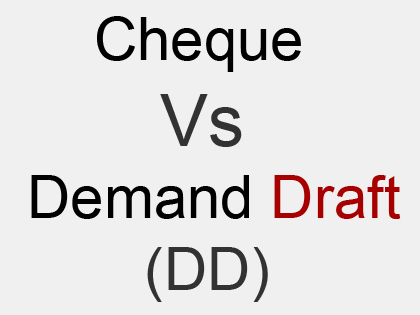Difference Between Cheque and Demand Draft DD - Distinguish
 1. Meaning
1. Meaning
A cheque is an unconditional order directing the banker to pay a certain sum of money only to or to the order of a certain person.
A draft is an order to pay money drawn by one office of a bank upon another office of the same bank for a sum of money payable to order on demand.
Image credits © Moon Rodriguez.
 2. Facility
2. Facility
The current account and saving account holders get a cheque facility.
Draft is issued to anyone even to non-account holders.
 3. Purpose
3. Purpose
Cheques are used to make payments or to settle transactions. There is no certainty of payment in the case of cheques as they can be dishonoured or payment can be stopped.
The main purpose of a draft is to transfer money from one place to another or to guarantee the certainty of payment to the payee.
 4. Drawer
4. Drawer
In case of cheque, the drawer is the customer of the bank.
In case of draft, the drawer is the bank itself.
 5. Bank charges
5. Bank charges
The bank may not charge for issuing the cheque book.
The bank charges a nominal fee or commission to issue a draft.
 6. Dishonour
6. Dishonour
Cheques can be dishonoured for various reasons.
There is no question of dishonouring of draft.
 7. Stopping of payment
7. Stopping of payment
In case of cheque, the drawer can ask the bank to stop payment of the cheque even if it is delivered to the payee.
In case of draft, the purchaser of the draft can ask the bank to stop payment before the draft is delivered to the payee.
 8. Popularity
8. Popularity
Cheques are very common and popular mode of payment.
Drafts do not enjoy much popularity as compared to cheques.
 9. Clearance
9. Clearance
In case of cheque, there is a need for clearance.
In case of a draft, there is no need for clearance, if DD is drawn on the same bank.
 10. Parties involved
10. Parties involved
Three parties are involved in cheque transaction viz., (a) Drawer, (b) Drawee, and (c) Payee.
Two parties are involved in draft transaction viz., (a) Drawer, and (b) Payee.

No Comment Yet
Please Comment